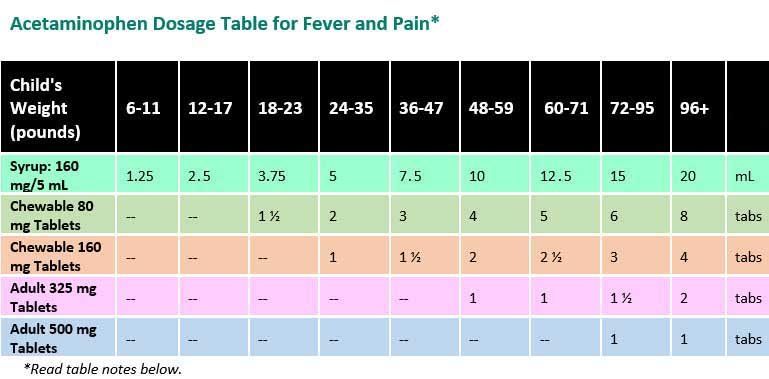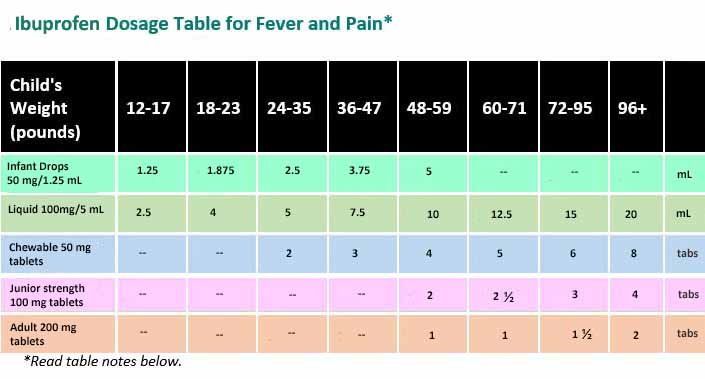Medication Dosage Table For Fever And Pain
Acetaminophen (i.e., Tylenol®, Feverall®, Tempra®) is an over-the-counter medicine used to reduce fever and relieve pain. Improper dosing is one of the biggest problems in giving acetaminophen to children. This chart, based on your child's weight, can help determine the right dosage amount, but is no substitute for your pediatrician's advice.

Table Notes
- Caution: In 2011, the U.S. Food and Drug Administration (FDA) recommended liquid, chewable, and tablet forms of acetaminophen be made in just one strength. Since that time, manufacturers and retailers of pediatric acetaminophen have voluntarily worked to change the amount of acetaminophen in these medicines to one standard amount (160 milligrams [mg]). Some manufacturers have recently made chewable tablets into a single strength of 160 mg. Infant drops are no longer available. Liquid syrup acetaminophen is available as 160mg/5mL. Pediatric acetaminophen products on store shelves can continue to be used as labeled.
- Age limit: Do not use acetaminophen under 12 weeks of age unless directed by your pediatrician because fever during the first 12 weeks of life should be documented in a medical setting. If a fever is present, your baby needs a complete evaluation. (Exception: Fever from an immunization in a child 8 weeks of age or older. If present, please consult with your pediatrician.)
- Combination products: Avoid multi-ingredient products in children under 6 years of age.
- Dosage: Determine by finding child's weight (in pounds) in the top row of the dosage table.
- Measuring the dosage (in metric units): Dosing syringes are more accurate than household utensils. Use the syringe or device that comes with the medication. If one does not come with the medication, ask the pharmacist for a medicine syringe. Household spoons are not reliable.
- Frequency: Repeat every 4-6 hours as needed. Don't give more than 5 times a day.
- Oral disintegrating tablets: These are dissolvable tablets that come in 80 mg and 160 mg (junior strength)
- Suppositories: Acetaminophen also comes in 80, 120, 325 and 650 mg suppositories. The rectal dose is the same as the dosage given by mouth.
- Extended-Release: Avoid 650 mg oral extended-release products in children.
SOURCE: American Academy of Pediatrics
Ibuprofen Dosage Table For Fever And Pain
Ibuprofen (i.e., Motrin®, Advil®) is an over-the-counter medicine used to reduce fever and relieve pain. This chart, based on your child's weight, can help determine the right dosage amount, but is no substitute for your pediatrician's advice.

TABLE NOTES
- Age limit: Don't use under 6 months of age unless directed by your child's pediatrician, because safety has not established and doesn't have FDA approval. Avoid multi-ingredient products in children under 6 years of age.
- Dosage: Determine by finding child's weight in the top row of the dosage table.
- Measuring the dosage (should be in metric units): Dosing syringes are more accurate than household utensils. Use the syringe or device that comes with the medication. If not available with the medication, medicine syringes are available at pharmacies. Household spoons are not reliable. Note: 1 level teaspoon equals 5 mL and that ½ teaspoon equals 2.5 mL.
- Ibuprofen drops: Ibuprofen infant drops come with a measuring syringe
- Adult dosage: 400 mg
- Frequency: Repeat every 6-8 hours as needed.
SOURCE: American Academy of Pediatrics
